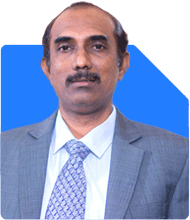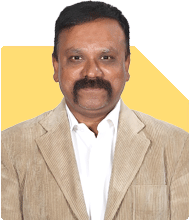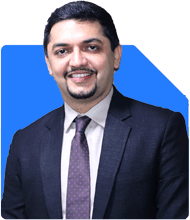Ramalingam Kalirajan |10872 Answers |Ask -Follow
Mutual Funds, Financial Planning Expert - Answered on Jun 26, 2024
He has an MBA in finance from the University of Madras and is a certified financial planner.
He is the director and chief financial planner at Holistic Investment, a Chennai-based firm that offers financial planning and wealth management advice.... more

I have property worth 60lakhs that is plot, what are the investment options available?
Before exploring investment options, it's crucial to understand your financial goals. You might aim for long-term wealth accumulation, children's education, retirement planning, or a combination of these. Defining clear objectives helps in choosing the right investment avenues.
Diversification: The Key to Successful Investing
Diversification is vital in investment planning. Spreading investments across different asset classes reduces risk and enhances potential returns. Let's explore various investment options that align with your financial goals.
Mutual Funds: A Balanced Approach
Equity Mutual Funds
Equity mutual funds invest in stocks, offering high growth potential. They suit investors with a higher risk tolerance and a long-term investment horizon. Equity funds can provide significant returns over time, outpacing inflation and helping achieve financial goals.
Debt Mutual Funds
Debt mutual funds invest in fixed income securities like bonds and treasury bills. They are less risky than equity funds and provide stable returns. They are ideal for investors seeking regular income and lower risk exposure.
Hybrid Mutual Funds
Hybrid funds invest in a mix of equities and debt. They balance risk and return, making them suitable for moderate risk-takers. These funds provide growth potential while mitigating risk through diversification.
Benefits of Regular Funds
Investing through a Mutual Fund Distributor (MFD) with a Certified Financial Planner (CFP) credential can be beneficial. MFDs provide personalized advice, helping you choose funds that align with your goals. They also offer ongoing portfolio management and support.
Public Provident Fund (PPF): A Safe and Secure Option
PPF is a government-backed savings scheme offering attractive interest rates. It has a lock-in period of 15 years, making it a long-term investment. PPF is suitable for risk-averse investors seeking assured returns and tax benefits under Section 80C of the Income Tax Act.
National Pension System (NPS): Planning for Retirement
NPS is a government-sponsored pension scheme aimed at providing retirement income. It offers two types of accounts: Tier I (mandatory retirement account) and Tier II (voluntary savings account). NPS investments are diversified across equities, corporate bonds, and government securities. It provides tax benefits and helps in building a retirement corpus.
Gold: A Traditional and Reliable Asset
Physical Gold
Investing in physical gold, like jewelry or coins, is a traditional method. It provides a hedge against inflation and economic uncertainties. However, it comes with storage and security concerns.
Gold ETFs and Sovereign Gold Bonds
Gold ETFs and Sovereign Gold Bonds are modern investment options. They offer the benefits of gold without the hassles of storage. Sovereign Gold Bonds also provide periodic interest, enhancing returns.
Fixed Deposits (FDs): Stability and Security
Fixed Deposits are a popular investment choice in India. They offer guaranteed returns and capital protection. FDs are suitable for conservative investors seeking stable income. However, the returns might be lower compared to other investment options.
Corporate Bonds: Higher Returns with Moderate Risk
Corporate bonds are debt securities issued by companies to raise capital. They offer higher returns than government bonds but come with moderate risk. Investing in high-rated corporate bonds can provide regular income and capital appreciation.
Unit Linked Insurance Plans (ULIPs): Dual Benefits
ULIPs offer the dual benefits of investment and insurance. They invest in a mix of equity and debt funds, providing market-linked returns. ULIPs also offer life cover, ensuring financial security for your family. However, they come with higher charges compared to mutual funds.
Health and Term Insurance: Protecting Your Financial Future
Health Insurance
Health insurance is crucial to cover medical expenses. It protects your savings and ensures access to quality healthcare. Choose a comprehensive health insurance plan with adequate coverage for your family.
Term Insurance
Term insurance provides high life cover at low premiums. It ensures financial security for your family in case of your untimely demise. Choose a term plan with adequate coverage based on your financial obligations and future goals.
Avoiding Common Investment Mistakes
Over-Reliance on Single Investment
Avoid putting all your money into one investment. Diversify across different asset classes to reduce risk and enhance returns.
Ignoring Inflation
Consider inflation while planning investments. Choose options that provide returns above the inflation rate to maintain purchasing power.
Lack of Regular Review
Regularly review your investment portfolio to ensure it aligns with your goals. Make necessary adjustments based on market conditions and personal circumstances.
Emotional Investing
Avoid making investment decisions based on emotions. Stick to your financial plan and make informed decisions.
Seeking Professional Guidance
A Certified Financial Planner (CFP) can help create a comprehensive financial plan. They provide personalized advice, ensuring your investments align with your goals and risk tolerance. Engaging a CFP ensures disciplined investing and helps achieve long-term financial success.
Benefits of Actively Managed Funds
Professional Management
Actively managed funds are managed by professional fund managers. They conduct extensive research and make informed investment decisions, aiming to outperform the market.
Potential for Higher Returns
Actively managed funds have the potential to deliver higher returns compared to index funds. Fund managers can take advantage of market opportunities and mitigate risks through active management.
Flexibility
Actively managed funds offer flexibility in investment strategies. Fund managers can adjust the portfolio based on market conditions and economic trends, enhancing performance.
Disadvantages of Index Funds
Lack of Flexibility
Index funds are passively managed and track a specific index. They lack flexibility to adjust to market conditions, which can limit returns.
Potential Underperformance
Index funds may underperform actively managed funds during market downturns. They cannot capitalize on market opportunities or mitigate risks effectively.
Limited Scope
Index funds have limited scope for diversification. They invest in a fixed set of securities, which might not align with your investment goals and risk tolerance.
Conclusion
Investing Rs 60 lakhs wisely requires understanding your financial goals, diversifying investments, and seeking professional guidance. By exploring various options like mutual funds, PPF, NPS, gold, FDs, and corporate bonds, you can create a balanced and robust investment portfolio. Engaging a Certified Financial Planner ensures disciplined and informed investing, helping you achieve long-term financial success.
Best Regards,
K. Ramalingam, MBA, CFP,
Chief Financial Planner,
www.holisticinvestment.in
You may like to see similar questions and answers below
Ramalingam Kalirajan |10872 Answers |Ask -Follow
Mutual Funds, Financial Planning Expert - Answered on Jul 06, 2024
Ramalingam Kalirajan |10872 Answers |Ask -Follow
Mutual Funds, Financial Planning Expert - Answered on Oct 10, 2024
Ramalingam Kalirajan |10872 Answers |Ask -Follow
Mutual Funds, Financial Planning Expert - Answered on Apr 29, 2025
Ramalingam Kalirajan |10872 Answers |Ask -Follow
Mutual Funds, Financial Planning Expert - Answered on Jul 30, 2025
Radheshyam Zanwar |6735 Answers |Ask -Follow
MHT-CET, IIT-JEE, NEET-UG Expert - Answered on Dec 06, 2025
Dr Nagarajan J S K |2576 Answers |Ask -Follow
NEET, Medical, Pharmacy Careers - Answered on Dec 06, 2025
Mihir Tanna |1090 Answers |Ask -Follow
Tax Expert - Answered on Dec 06, 2025
Ramalingam Kalirajan |10872 Answers |Ask -Follow
Mutual Funds, Financial Planning Expert - Answered on Dec 06, 2025
Radheshyam Zanwar |6735 Answers |Ask -Follow
MHT-CET, IIT-JEE, NEET-UG Expert - Answered on Dec 06, 2025
Radheshyam Zanwar |6735 Answers |Ask -Follow
MHT-CET, IIT-JEE, NEET-UG Expert - Answered on Dec 06, 2025
Radheshyam Zanwar |6735 Answers |Ask -Follow
MHT-CET, IIT-JEE, NEET-UG Expert - Answered on Dec 06, 2025
Dr Dipankar Dutta |1837 Answers |Ask -Follow
Tech Careers and Skill Development Expert - Answered on Dec 05, 2025
Dr Shyam Jamalabad |108 Answers |Ask -Follow
Dentist - Answered on Dec 05, 2025
Dr Shyam Jamalabad |108 Answers |Ask -Follow
Dentist - Answered on Dec 05, 2025











.jpg)














